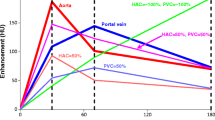Summary
The vascularization of 19 human livers with metastases was investigated using gelatine perfusion and resin corrosion techniques. (1) In 16 livers examined after injection via the hepatic artery hypervascular metastases were demonstrated in 12 cases, hypovascular in 4. (2) Injection via the portal vein showed that more than 50% of liver metastases had a distinct portal blood supply to the tumor periphery. In approximately one-third of cases the portal blood supply extended centrally. (3) Injection via the hepatic vein demonstrated venous drainage from peripheral areas of tumor in less than 30%, and from central areas in only 9%. Larger branches of the hepatic vein were not detected within metastases. (4) Tumor thrombi were seen within branches of the portal vein situated 1–1.5 cm from the tumor periphery in more than 50% of all liver metastases — suggesting the possibility of local hepatic retrograde tumor spread via the portal vein. (5) Central necroses were seen in hypervascular metastases only, mainly in tumors larger than 1–1.5 cm. (6) The incidence and vascularity of human hepatic micrometastases was investigated. Micrometastases were seen in close proximity to about 40% of the macrometastases. Metastases up to the size of 200 μm received their main blood supply via sinusoids. Neovascularization of tumors larger than 200 μm was demonstrated.
Similar content being viewed by others
References
Ackerman NB (1972) Experimental studies on the circulatory dynamics of intrahepatic tumor blood supply. Cancer 29:435–439
Aigner K, Walther H, Term J, Wenzl A, Hechtel R, Merker G, Schwemmle K (1983) First experimental and clinical results of isolated liver perfusion with cytotoxics in metastases from colorectal primary. Recent Results Cancer Res 86:99–102
Almersjoe O, Bengmark S, Rudenstam CM, Hafstroem L, Nilsson LAV (1972) Evaluation of hepatic dearterialization in primary and secondary cancer of the liver. Am J Surg 124:5–9
Bedikian AY, Chen TT, Patt YZ, Bodey GP (1984) Prognostic factors influencing survival of patients with advanced colorectal cancer: hepatic-artery infusion versus systemic intravenous chemotherapy for liver metastases. J Clin Oncol 2:174–180
Breedis C, Young G (1954) Blood supply of neoplasms in the liver. Am J Pathol 30:969–985
Carlsson G, Ekelund L, Stigsson L, Hafstroem L (1983) Vascularization and tumor volume estimations of solitary liver tumors in rats. Ann Chir Gynaecol 72:187–191
Fischer HP, Schulz A, Kracht J, Aigner K (1984) Perfusionstherapie von Lebermetastasen — Morphometrische Auswertung der spontanen und therapiebedingten Tumorregression. Verh Dtsch Ges Pathol 68:230–234
Goldmann E (1907) Die Beziehungen des Gefäßsystems zu den malignen Neubildungen. Z Krebsforsch 5:39–48
Healey JE Jr (1965) Vascular patterns in human metastatic liver tumors. Surg Gynecol Obstet 120:1187–1193
Honjo I, Matsumura H (1965) Vascular distribution of hepatic tumors. Experimental study. Circ Innerv Hepat 15:681–690
Lin G, Lunderquist A, Haegerstrand I, Boijsen E (1984) Postmortem examination of the blood supply and vascular pattern of small liver metastases in man. Surgery 96:517–526
Lindell B, Aronsen KF, Rothmann U, Sjoegren HO (1977) The circulation in liver tissue and experimental liver metastases before and after embolization of the liver artery. Res Exp Med 171:63–70
Nilsson LAV, Zettergren L (1967) Effect of hepatic artery ligation on induced primary liver carcinoma in rats. Acta Pathol Microbiol Scand 71:187–193
Nilsson LAV, Rudenstam CM, Zettergren L (1967) Vascularisation of liver tumors and the effect of hepatic artery ligature. Bibl Anat 9:425–431
Oberfield RA (1983) Prolonged and continuous percutaneous intraarterial hepatic infusion chemotherapy in advanced metastatic liver adenocarcinoma from colorectal primary. Recent Results Cancer Res 86:49–62
Paris AL, Meissner WA, Mc Dermott WV (1982) Histologic changes seen in the hepatic parenchyma and in metastatic nodules following hepatic dearterialization. J Surg Oncol 19:114–118
Peterson HP (ed) (1979) Tumor blood circulation. CRC Press, Boca Raton
Romeis B (1963) Mikroskopische Technik. Verlag R. Oldenbourg, München
Segall HN (1923) An experimental anatomical investigation of the liver. Surg Gynecol Obstet 37:152–178
Strohmeyer T, Haugeberg G, Lierse W (1986) Vaskularisation von Lebermetastasen: eine korrosionsanatomische Studie. Acta Anat 126:172–176
Suzuki T, Sarumaru S, Kawabe K, Honjo I (1972) Study of vascularity of tumors of the liver. Surg Gynecol Obstet 134:27–34
Taylor I, Bennett R, Sheriff S (1979) The blood supply of colorectal liver metastases. Br J Cancer 39:749–756
Wright RD (1937) The blood supply of newly developed epithelial tissue in the liver. J Pathol Bacteriol 45:405–414
Author information
Authors and Affiliations
Additional information
Supported by Deutsche Forschungsgemeinschaft (DFG)
This study is part of the thesis by G. Haugeberg
Rights and permissions
About this article
Cite this article
Haugeberg, G., Strohmeyer, T., Lierse, W. et al. The vascularization of liver metastases. J Cancer Res Clin Oncol 114, 415–419 (1988). https://doi.org/10.1007/BF02128188
Received:
Accepted:
Published:
Issue Date:
DOI: https://doi.org/10.1007/BF02128188



